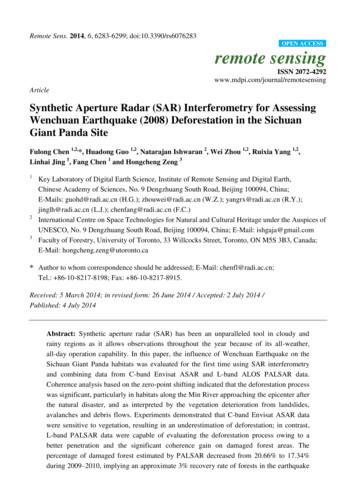SYNTHETIC APERTURE RADAR POLARIMETRY
SYNTHETIC APERTURERADAR POLARIMETRYJAKOB VAN ZYLYUNJIN KIMJet Propulsion LaboratoryCalifornia Institute of Technology WILEYA JOHN WILEY AND SONS, INC., PUBLICATION
CONTENTSNOTE FROM THE SERIES VxviixixSYNTHETIC APERTURE RADAR (SAR) IMAGING BASICS1.11.21.31.41.51.6Basic Principles of Radar Imaging / 2Radar Resolution / 6Radar Equation / 1 0Real Aperture Radar / 1 1Synthetic Aperture Radar / 1 3Radar Image Artifacts and Noise / 161.6.1 Range and Azimuth Ambiguities / 161.6.2 Geometric Effects and Projections / 191.6.3 Signal Fading and Speckle / 201.7 Summary / 22References / 22vii
CONTENTSBASIC PRINCIPLES OF SAR POLARIMETRY2.12.22.32.42.5Polarization of Electromagnetic Waves / 23Mathematical Representations of Scatterers / 27Implementation of a Radar Polarimeter / 32Polarization Response / 34Optimum Polarizations / 532.5.1 General (Bistatic) Case / 542.5.2 Backscatter (Monostatic) Case / 562.5.3 Special Case: Single Scatterer in Backscatter(Monostatic) Case / 582.5.4 Special Case: Multiple Scatterers with ReflectionSymmetry / 6 12.5.5 A Numerical Example / 632.6 Contrast Enhancement / 652.6.1 Numerical Example / 672.6.2 Image Example / 692.7 Summary / 71References / 7 1ADVANCED POLARIMETRIC CONCEPTS3.13.2Vector-Matrix Duality of Scatterer Representation / 73Eigenvalue- and Eigenvector-Based Polarimetrie Parameters / 763.2.1 Parameters Used to Describe Randomnessin Scattering / 763.2.2 Alpha Angle / 803.3 Decomposition of Polarimetrie Scattering / 883.3.1 Scattering Decomposition in the Incoherent Case UsingOrthonormal Bases / 9 13.3.2 Model-Based Scattering Decomposition in theIncoherent Case / 963.4 Image Classification / 1 2 53.4.1 Supervised Classification / 1283.4.2 Physics-Based Unsupervised Classification / 1323.4.3 Combined Unsupervised and Bayes ClassificationAlgorithms / 1 3 33.5 Polarimetrie SAR Interferometry / 1 3 53.6 Summary / 1 4 1References / 141
CONTENTS4POLARIMETRIC SAR CALIBRATIONiX1454.14.24.34.4Polarimetrie Radar System Model / 1 4 5Cross Talk Estimation and Removal / 152Copolarized Channel Imbalance Calibration / 161Absolute Radiometrie Calibration / 1 6 64.4.1 Effect of Topography on Scattering Area / 1694.4.2 Effect of Topography on Antenna Pattern Corrections / 1744.4.3 AIRSAR Image Example / 1764.5 Faraday Rotation / 1774.6 Summary / 179References / 1 8 05 APPLICATIONS: MEASUREMENT OF SURFACESOIL MOISTURE5.15.25.35.45.55.65.7Surface Electrical and Geometrical Properties / 1 8 35.1.1 Geometrical Properties / 1 8 35.1.2 Electrical Properties / 1 8 85.1.3 Penetration Depth / 1 9 15.1.4 Soil Moisture Profile / 193Scattering from Bare Rough Surfaces / 1 9 65.2.1 First-Order Small-Perturbation Model / 1995.2.2 The Integral Equation Model / 199Example Bare Surface Soil Moisture Inversion Models / 2015.3.1 The First-Order Small-Perturbation Model / 2015.3.2 Algorithm Proposed by Oh et al. (1992) / 2055.3.3 Algorithm Proposed by Dubois et al. / 2075.3.4 Algorithm Proposed by Shi et al. (1997) / 209Comparison of the Performance of Bare SurfaceInversion Models / 2 1 1Parameterizing Scattering Models / 216Inverting the IEM Model / 2225.6.1 Using a Data Cube / 223Scattering from Vegetated Terrain / 2255.7.1 Scattering from the Vegetation Layer (Scattering Path 1) / 2285.7.2 Backscatter from the Underlying Ground Surface(Scattering Path 4) / 2325.7.3 Double-Reflection Scattering (Scattering Paths 2 and 3) / 233182
XCONTENTS5.8Simulation Results / 2395.8.1 Effect of the Angle of Incidence / 2395.8.2 Effect of Cylinder Radius / 2425.8.3 Effect of Cylinder Moisture / 2435.8.4 Radar Vegetation Index / 2445.8.5 Effect of Soil Moisture / 2475.8.6 Inverting for Soil Moisture: the Data Cube / 2505.9Time Series Estimation of Soil Moisture / 2525.10 Summary / 257References / 2 5 8AppendixesA TILTED SMALL PERTURBATION MODEL DETAILSВС262BISTATIC SCATTERING MATRIX OF A CYLINDER WITHARBITRARY ORIENTATION267NOMENCLATURE276INDEX279
SYNTHETIC APERTURE RADAR (SAR) IMAGING BASICS 1.1 Basic Principles of Radar Imaging / 2 1.2 Radar Resolution / 6 1.3 Radar Equation /10 1.4 Real Aperture Radar /11 1.5 Synthetic Aperture Radar /13 1.6 Radar Image Artifacts and Noise / 16 1.6.1 Range and Azimuth Ambi
Keywords : Inverse Synthetic Aperture Radar (ISAR), Range Profile Alignment, Air Target Rotational Motion Compensation, Super-resolution Decimative Spectrum Estimation Method (DESED), Coherent Processing Interval (CPI). 1. INTRODUCTION Inverse synthetic aperture radar (ISAR) is a radar technique to obtain a high
The theoretical representation of Inverse Synthetic Aperture Radar systems is the dual of a Synthetic Aperture Radar system in spotlight mode, as shown in Figure 2(a) [Wehner, 1998]. And to introduce the wider concept of radar imaging we have included Figure 2(b). From Figure 2(b) we derive the final simulation
Keywords: SAR interferometry; coherence; Wenchuan Earthquake; giant panda habitat 1. Introduction Interferometric synthetic aperture radar (InSAR) or differential interferometric synthetic aperture radar (DInSAR) is a quantitat
4.Polarimetric Remote Sensing 5.Thesis Topics. INTRODUCTION. INTRODUCTION What is Radar Polarimetry. INTRODUCTION What is Radar Polarimetry The information contained into backscattered waves from a given target is highly related to: Ægeometrical structure Æreflecti
Basics of Radar Polarimetry . “Polarimetry” in Radar, Lidar/Ladar and SAR Sensing and Imaging [12, 14, 15, 19] - using the ancient . Very remarkable improvements beyond classical “non-polarimetric” radar target detection, recognition and discrimination, and identification were ma
called spotlight mode SAR and it is a favorite technique for military reconnaissance. One can perform the same type of analysis with any 2-D aperture; many analytic examples are given in Figure 12.4 from Bracewell 1978. Below we'll be using a rectan-gular aperture when we discuss synthetic aperture radars. For now, consider a uniform
Keywords: Inverse synthetic aperture radar, ISAR imaging, image processing, neural network recognition. 1. Introduction . In latest years producing of high quality Inverse Synthetic Aperture Radar (ISAR) images of moving targets becomes a great challenge for researches in radar world.
3/15/2021 6105636 lopez richard 3/15/2021 5944787 padilla elizabeth 3/15/2021 6122354 rodriguez alfredo 3/16/2021 6074310 aldan francisco 3/16/2021 6060380 bradley vincent 3/16/2021 6133841 camacho victor 3/16/2021 6100845 cardenas cesar 3/16/2021 6133891 castaneda jesse .























